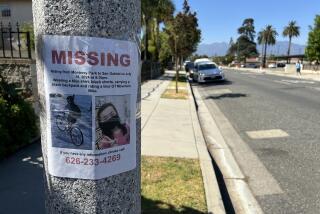City Battling Garcetti Over Graffiti Law : Crime: Culver City officials want to pass a tough ordinance to punish taggers. But D.A.’s office contends it is the prosecuting agent for all juvenile crimes.
Culver City officials are battling with Los Angeles County Dist. Atty. Gil Garcetti for the right to prosecute minors under a proposed anti-graffiti ordinance that city officials say is among the toughest in Los Angeles County.
The graffiti proposal, to be considered by the City Council on Monday night, would impose penalties on taggers, including the revocation of their driver’s licenses, jail time, fines and community service work. It would also require that graffiti removal be paid for by owners of property where repeated tagging has occurred.
City officials say they are proposing the measures because Garcetti’s office has failed to enforce state graffiti-abatement provisions already on the books. They say that for the past year, the city has unsuccessfully pressed the district attorney to allow it to handle its own graffiti enforcement.
“Graffiti is not worse in Culver City, we just have less tolerance for it,” said Vice Mayor Steven Gourley. “We don’t want our city to look like Los Angeles. It’s ugly, and there’s no enforcement.”
The district attorney’s office contends that it is the prosecuting agent for all juvenile crimes, and should remain so. “We can’t separate some crimes and hand them to certain cities,” said Sandi Gibbons, a spokeswoman for the district attorney’s office.
Culver City officials say the need for an anti-graffiti drive is clear. The city, they point out, has spent $54,000 in the past year to clean up more than 1,900 graffiti markings.
Perhaps the highest-profile provision in the proposal would suspend the driving privileges of convicted taggers--a sure-fire way to stop young offenders, said one school official.
“That’s the most important thing to them--their license,” said William Coates, assistant principal of Culver City High School. “Some of the hardened kids, the ones who are really involved in gangs, there’s not much else you can do to embarrass them.”
Under the proposed ordinance, taggers would also be fined up to $50,000, jailed for up to a year and sentenced to perform up to four days of community service.
“I want to see them clean up school property . . . embarrass them and make them do it in front of their peers,” Gourley said.
Minors would be prohibited from carrying “graffiti implements”--including spray paint, markers and etching devices--in most public places when a parent or a guardian is not present. The responsibility of paying fines would fall to the parents, and parents unable to pay would be sentenced to the same community service time as their children.
The proposed ordinance also targets property owners. Culver City would clean up graffiti four times on the same property but, after that, property owners would be asked to voluntarily clean it up or pay the city to do it.
If, six months after the ordinance takes effect, the council determines that property owners are not responding, such payments will become mandatory and property owners who fail to make them would face penalties of up to $1,000 and six months in jail.
“Cleaning up graffiti is (business’ and homeowners’) responsibility,” Gourley said. “There are some people, like absentee landlords, that won’t do anything about it.”
Although Culver City considers its proposed ordinance to be the strongest anti-graffiti measure in the county, the city of Los Angeles punishes taggers much the same way--with, among other penalties, community service work and the suspension of driving privileges, according to Delphia Jones, director of Los Angeles’ Operation Clean Sweep.
But compared to other cities, Culver City is going a step farther.
Taggers in Santa Monica do not have their driving privileges suspended, said Helen Albright, who handles graffiti enforcement in Santa Monica. And although the city requires offenders to clean up graffiti, it assigns fewer hours of community service for each violation than Culver City is proposing.
There is a reason for Santa Monica’s softer approach, Albright said.
“Too much, and kids get resentful,” she said. “You can go too far.”
More to Read
Sign up for Essential California
The most important California stories and recommendations in your inbox every morning.
You may occasionally receive promotional content from the Los Angeles Times.






